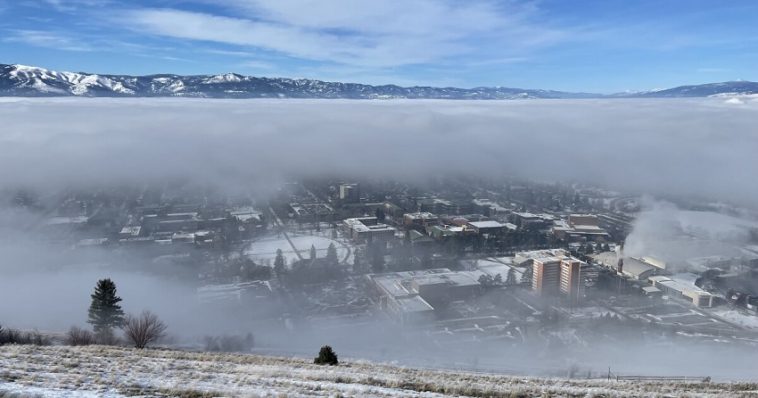Missoula, MT – As winter settles over Missoula, the beautiful valleys and mountains that define the area also create challenges for air quality. While fire season smoke is often the first concern for residents, the colder months bring their own set of problems. High pressure systems, light winds, and freezing temperatures can trap pollutants in the valleys, leading to dangerously poor air quality, especially in the city’s more rural areas.
According to Taylor Schaeffer, an air quality specialist with Missoula Public Health, Missoula’s unique topography is both a blessing and a curse when it comes to air quality. “We’re really lucky to live in a place surrounded by mountains and valleys, but that geography makes air quality tricky during the winter months,” Schaeffer explained.
The issue primarily arises from a weather phenomenon known as “inversion.” During winter, cold air sinks into the valley floor, while warmer air rises. This creates a sort of “lid” on the valley, trapping pollutants in the cold air below. As a result, the pollutants—whether from wood stoves, vehicles, or industrial sources—cannot disperse, leaving residents to breathe them in throughout the day.
Tony Ward, a professor at The University of Montana’s School of Public and Community Health Sciences, explained that Missoula’s winter air pollution is exacerbated by both the geography and local practices. “Because we live in valleys, because we have these temperature inversions, and because of the amount of wood burning, especially in more rural areas, we see some of the worst air quality in the winter months,” Ward said.
The impacts of poor air quality are felt most acutely by vulnerable populations, including children, the elderly, and those with existing health conditions. Breathing in pollutants can lead to a variety of health problems, ranging from respiratory issues like asthma to heart disease. In more immediate cases, residents may experience symptoms such as watery eyes, sneezing, or coughing, which are similar to the effects seen during wildfire smoke events.
Yet, it’s not just the outdoor air that poses a threat. Ward emphasized that indoor air quality can often be just as bad—if not worse—than what’s found outside. “We tend to overlook the fact that indoor air can still be polluted, even if we’re not outside,” he said. Everyday activities such as cooking, cleaning, vacuuming, and even lighting candles can introduce pollutants into indoor environments. With many people spending upwards of 90% of their day indoors during winter, this can create a significant health risk.
For Schaeffer, the key to mitigating the impact of poor air quality is ensuring that both indoor and outdoor environments allow for proper ventilation and mixing of air. “If there’s bad air outside, we want to keep it from coming inside. And if there’s pollution inside, it has to be able to escape, with fresh air coming in,” she said.
To help combat these air quality issues, both Schaeffer and Ward recommend a variety of practical steps for residents. These include checking real-time air quality data on sites like AirNow.gov, using air filters indoors, reducing car idling, minimizing the use of wood stoves, and limiting time spent outdoors when air quality is unhealthy. Schaeffer also suggests that residents look for indoor alternatives for physical activity, such as yoga or dance classes, rather than braving the unhealthy outdoor air for a run or a ski.
Missoula Public Health is actively working to monitor and improve air quality in the area, but experts agree that residents can play a vital role in protecting their own health by staying informed and taking precautions during the winter months. As the valley continues to experience inversions and pollution levels rise, it’s more important than ever for Missoula’s residents to take action to safeguard their health.



